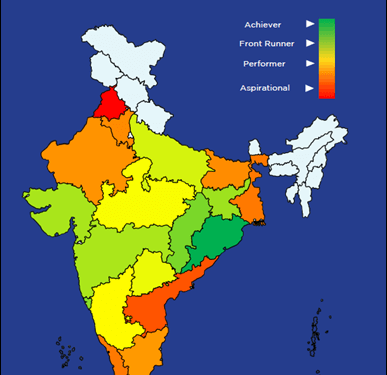The recently launched Fiscal Health Index (FHI) 2025 by NITI Aayog has sparked nationwide discussions about the fiscal resilience of Indian states. While Odisha, Chhattisgarh, and Goa dominate the rankings, Bihar’s classification as a “performer” offers both reassurance and a roadmap for improvement. This analysis delves into Bihar’s fiscal standing, contextualises its challenges, and explores pathways to sustainable growth.
National Overview of Fiscal Health Index 2025
The FHI evaluates 18 major states across five sub-indices:
- Quality of Expenditure (developmental vs. non-developmental spending)
- Revenue Mobilisation (self-generated revenue capacity)
- Fiscal Prudence (deficit and borrowing management)
- Debt Index (liability burden relative to economic output)
- Debt Sustainability (GSDP growth vs. interest payments)
Key Rankings:
| Category | States |
|---|---|
| Front-runners | Odisha (67.8), Chhattisgarh (55.2), Goa (53.6) |
| Performers | Tamil Nadu, Bihar, Rajasthan, Haryana |
| Aspirational | Punjab (10.7), Andhra Pradesh, West Bengal, Kerala |
Odisha’s leadership stems from low fiscal deficits (3.1% of GSDP), high capital expenditure (27% of spending), and mining-linked revenue streams. Conversely, Punjab’s debt-to-GSDP ratio (48.9%) and Kerala’s interest payments (₹47,202 crore in 2022–23) reflect systemic vulnerabilities.
Bihar’s Fiscal Health: A Mid-Tier Performer
Bihar’s classification in the “performer” category indicates moderate fiscal stability but highlights areas needing intervention. While specific scores for Bihar are not disclosed in publicly available reports, its grouping with Tamil Nadu and Rajasthan suggests:
Strengths:
- Debt Management: Likely maintains debt levels below crisis thresholds, avoiding Punjab-style debt traps.
- Revenue Streams: Potential growth in non-tax revenue, though lagging behind Odisha’s mining premiums or Goa’s tourism-linked collections.
Challenges:
- Revenue Mobilisation: Bihar’s own tax revenue stood at just ₹48,910 crore in 2022–23, heavily reliant on central transfers (83% of total revenue).
- Expenditure Quality: Only 12% allocated to capital expenditure in 2022–23, compared to Odisha’s 27%.
- Debt Sustainability: Interest payments consumed 15.3% of revenue receipts, limiting fiscal flexibility.
Comparative Analysis: Bihar vs. Neighbouring States
| Parameter | Bihar | Jharkhand (Improved) | West Bengal (Aspirational) |
|---|---|---|---|
| Revenue Mobilisation | Moderate | High non-tax mining revenue | Low tax compliance |
| Capital Outlay | 12% of GSDP | 18% of GSDP | 9% of GSDP |
| Debt-to-GSDP | 28% | 24% | 37% |
Jharkhand’s rise to 4th position—driven by coal royalties and austerity measures—offers replicable strategies for Bihar. Meanwhile, West Bengal’s struggles with debt sustainability (interest payments at 19% of revenue) underscore the risks of fiscal complacency.
Pathways for Bihar’s Fiscal Transformation
1. Augmenting Own Revenue:
- Expand tax base through digital compliance systems, targeting the untapped informal sector.
- Monetise public assets: Bihar’s 1,100+ government buildings in Patna alone could generate ₹500 crore annually via leases.
2. Debt Rationalisation:
- Refinance high-cost loans (12% average interest) via SDL swaps at sub-8% rates.
- Adopt Kerala’s liability management framework, which reduced interest burdens by ₹2,300 crore in 2023–24.
3. Expenditure Efficiency:
- Replicate Odisha’s outcome-based budgeting, which ties 60% of health spending to measurable targets.
- Reduce non-developmental expenses: Bihar spends ₹9,200 crore annually on electricity subsidies—a 40% reduction could fund 50,000 new classrooms.
Conclusion:
Bihar’s “performer” status in the FHI 2025 is a call for calibrated reforms rather than complacency. By prioritising revenue diversification (targeting 20% own tax revenue growth by 2026), debt restructuring, and smart capital allocation, Bihar could join the front-runners by FHI 2030. However, this requires political will to transcend populist policies—a lesson starkly evident in Punjab’s fiscal collapse. As state finances increasingly dictate national economic trajectories, Bihar’s journey from performer to pacesetter will be pivotal for India’s $10 trillion GDP ambitions.
*Note: All data sourced from NITI Aayog’s Fiscal Health Index 2025 report and associated analyses.*

















